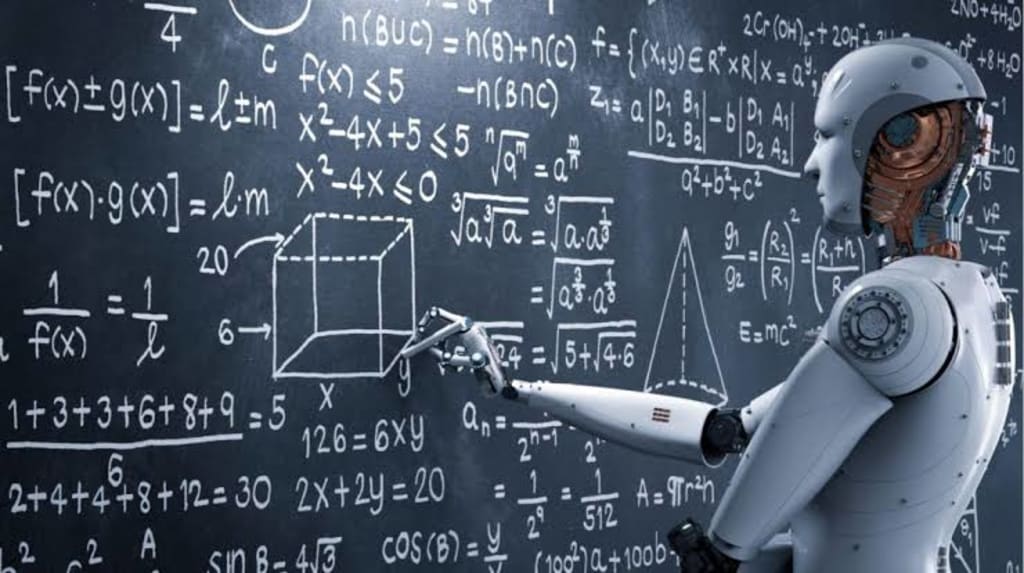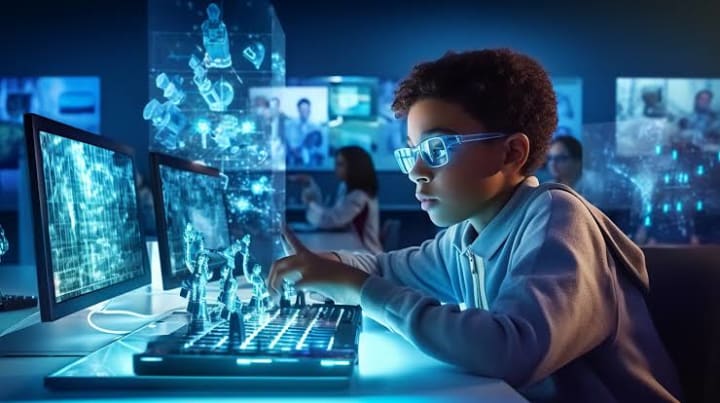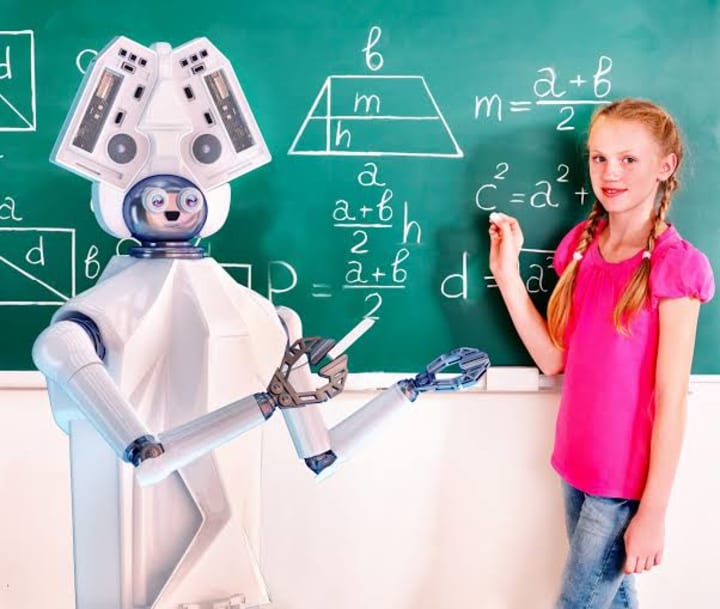The Transformative Power of AI in Education
The revolution of Education

Artificial Intelligence (AI) is revolutionizing various sectors, and education is no exception. As AI technologies evolve, they offer new possibilities for teaching, learning, and administration. This article delves into the myriad ways AI is transforming education, exploring its benefits, challenges, and future prospects.
#### Personalized Learning
One of the most significant impacts of AI in education is personalized learning. Traditional classrooms often struggle to cater to the individual needs of each student due to time and resource constraints. AI, however, can analyze a student's performance data and tailor educational content to their specific needs.

For instance, AI-driven platforms like DreamBox and Knewton use algorithms to assess students' strengths and weaknesses in real-time. These platforms then adjust the difficulty of problems, recommend specific exercises, and provide instant feedback, ensuring that students are neither bored by material that's too easy nor overwhelmed by content that's too difficult.
#### Intelligent Tutoring Systems
AI-powered tutoring systems provide personalized instruction to students outside of the traditional classroom setting. These systems, such as Carnegie Learning’s MATHia and Tutor.com, can deliver one-on-one tutoring that adapts to the learner's pace and style. These intelligent tutors can offer explanations, ask questions, and provide hints, much like a human tutor would.
Studies have shown that intelligent tutoring systems can significantly improve learning outcomes. For example, research on MATHia demonstrated that students using the system showed substantial gains in mathematics performance compared to those who did not.
#### Automating Administrative Tasks
AI is also streamlining administrative tasks, freeing up valuable time for educators to focus on teaching. Tasks such as grading, scheduling, and resource allocation can be time-consuming and tedious. AI systems like Gradescope and Turnitin use machine learning to grade assignments and detect plagiarism, providing fast and consistent evaluations.
Furthermore, AI can assist in scheduling by optimizing timetables based on numerous variables, such as teacher availability, room usage, and student preferences. This reduces the administrative burden on school staff and ensures that resources are used more efficiently.
#### Enhancing Accessibility
AI has the potential to make education more accessible to students with disabilities. For example, speech recognition technology can transcribe lectures for hearing-impaired students, while text-to-speech software can help those with visual impairments. AI can also provide real-time language translation, making educational content accessible to non-native speakers.
Applications like Microsoft’s Seeing AI describe the environment for visually impaired users, while tools like Google's Live Transcribe provide real-time speech-to-text transcription, making classrooms more inclusive.
#### Data-Driven Insights
AI can analyze vast amounts of data to provide educators with insights that can improve teaching strategies and student outcomes. Learning management systems (LMS) such as Canvas and Blackboard can track student engagement and performance, identifying patterns that might indicate a need for intervention.
For instance, predictive analytics can flag students who are at risk of falling behind, allowing educators to provide support before it's too late. This proactive approach can improve retention rates and ensure that more students succeed.
#### Virtual Classrooms and Distance Learning
The COVID-19 pandemic has accelerated the adoption of virtual classrooms and distance learning, and AI plays a crucial role in this transformation. AI can facilitate online learning environments that are interactive and engaging. Tools like Coursera and Khan Academy leverage AI to recommend courses and materials tailored to individual learners' needs and interests.

AI-driven chatbots and virtual assistants, such as IBM’s Watson Tutor, can provide 24/7 support to students, answering questions and guiding them through coursework. This ensures that learners have access to help whenever they need it, regardless of time zones or geographical barriers.
#### Enhancing Teacher Training
AI can also be used to improve teacher training and professional development. Simulations and virtual reality (VR) environments can provide teachers with realistic classroom scenarios where they can practice and hone their skills. AI can analyze their performance in these simulations and offer constructive feedback.
For example, platforms like TeachLivE use VR to create interactive classroom environments where teachers can practice managing different classroom situations. This helps educators develop their skills in a controlled, risk-free setting.
#### Ethical Considerations and Challenges
While AI offers numerous benefits, it also presents several ethical considerations and challenges that must be addressed.
**Privacy and Data Security:** The use of AI in education involves the collection and analysis of vast amounts of personal data. Ensuring the privacy and security of this data is paramount. Schools and AI providers must implement robust data protection measures and be transparent about how data is collected, stored, and used.
**Bias and Fairness:** AI systems can inadvertently perpetuate biases present in the data they are trained on. For example, if an AI system is trained on data that reflects historical inequalities, it may reinforce those inequalities in its recommendations and decisions. It's crucial to develop and train AI systems using diverse and representative data sets to mitigate bias.
**Teacher and Student Autonomy:** While AI can support and enhance the educational process, it should not replace the critical role of teachers. Educators bring essential human elements to the classroom, such as empathy, intuition, and the ability to inspire. AI should be seen as a tool that empowers teachers rather than as a replacement.
**Accessibility and Equity:** There is a risk that AI could widen the gap between those who have access to advanced technology and those who do not. Ensuring equitable access to AI tools and resources is essential to prevent exacerbating educational disparities.
#### The Future of AI in Education
The potential of AI in education is vast, and we are only beginning to scratch the surface of what is possible. As AI technologies continue to evolve, they will undoubtedly become more integrated into the educational landscape, providing even more innovative solutions to enhance learning and teaching.
**Adaptive Learning Systems:** Future AI systems will likely become even more sophisticated in personalizing learning experiences. These systems will be able to adjust in real-time to a student’s emotional and cognitive state, providing the right support at the right time.
**Lifelong Learning:** AI will play a crucial role in facilitating lifelong learning. As the job market evolves, continuous learning and upskilling will become essential. AI can help create personalized learning paths that evolve with an individual’s career and personal growth.
**Global Collaboration:** AI can facilitate global collaboration by breaking down language barriers and connecting students and educators from different parts of the world. This will foster a more inclusive and interconnected global educational community.
**Augmented Reality (AR) and Virtual Reality (VR):** AI-powered AR and VR will transform how subjects are taught, providing immersive and interactive learning experiences. For example, history lessons could take students on virtual tours of ancient civilizations, while science classes could allow them to explore the intricacies of the human body in 3D.
**Emotional AI:** Future AI systems may be capable of recognizing and responding to students’ emotional states. This could help create more supportive and responsive learning environments, where students feel understood and valued.
#### Conclusion
The integration of AI in education holds the promise of creating a more personalized, efficient, and inclusive learning experience. By harnessing the power of AI, educators can better cater to the diverse needs of students, streamline administrative tasks, and provide valuable insights that can improve educational outcomes.
However, the adoption of AI in education also comes with significant responsibilities. Ensuring data privacy, addressing biases, maintaining teacher and student autonomy, and promoting equitable access are crucial considerations that must be addressed to fully realize the potential of AI in education.
As we look to the future, it is clear that AI will continue to play a transformative role in education. By embracing these technologies thoughtfully and ethically, we can create an educational landscape that is more responsive to the needs of all learners, preparing them for the challenges and opportunities of the 21st century.
About the Creator
Local Man
I am a dedicated writer known for my versatility and creativity. With a strong passion for storytelling, engaging content across a variety of genres, including articles, blogs, and copywriting.
Enjoyed the story? Support the Creator.
Subscribe for free to receive all their stories in your feed. You could also pledge your support or give them a one-off tip, letting them know you appreciate their work.






Comments (1)
AI has a good side and, at the same time, a bad side. In this case, it's going to take a lot of jobs away from a lot of people.